Fracking Colorado
September 19, 2012: The People Deliver Their Message To Governor Hickenlooper
It began in the morning, when a group of citizens, representing numerous community groups across Colorado that are opposed to fracking, delivered a petition with over 8,000 signatures to Governor Hickenlooper. The petition asked the Governor to stop suing Longmont for passing rules that would protect the city by not allow fracking in residential areas. The Governor was not there to talk to these petition presenters, but they told one of his aides that we aren’t happy with how the state is failing to representing the citizens and failing to consider fracking’s costs to our health, safety, and quality of life.

Citizens delivering a petition, to Governor Hickenlooper’s aide, asking that the state refrain from suing Longmont.
http://blogs.denverpost.com/thebalancesheet/2012/09/20/fracking-6652/6652/
That same day, a letter was sent to the Governor, that was signed by over 70 Colorado public officials, criticizing the Governor for suing Longmont. See the full text of that letter at:
https://frackingcolorado.wordpress.com/letter-to-the-governor/
The day ended with Governor Hickenlooper visiting Longmont for a forum on fracking, set up by the local Chamber of Commerce, which wasn’t open to the public. Longmont citizens, who were fed up with the Governor ignoring the community and their concerns, rallied outside the Guaranty Bank where the meeting was held. See the below article for a full description, videos and photos.
http://www.timescall.com/news/longmont-local-news/ci_21588128/gov-hickenlooper-longmont-visit-draws-oil-gas-protesters?source=most_viewed _______________________________________________________________________________________________________
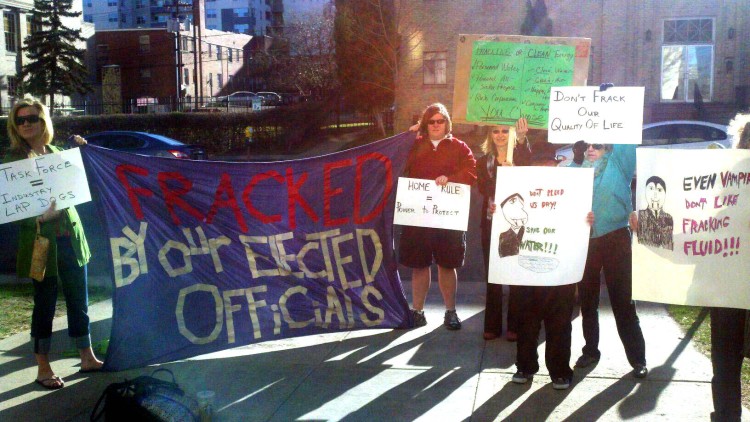
Colorado citizens protest the Governor’s Oil and Gas Task Force meeting in Denver, CO on March 22, 2012. Photo courtesy of Jen Palazzolo
________________________________________________________________________________________________________
Eighteen Colorado Groups Ask Governor Hickenlooper To Stop Misinforming The Public About Drillling/Frackiing Spills and Releases
Fort Collins, CO – March 13, 2012; Eighteen Colorado groups asked Governor Hickenlooper to stop misinforming the public about spills and releases of fluids involved with the oil and gas drilling and fracking process. Governor Hickenlooper was recently quoted in the press as saying, “There have been a few spills,” but information obtained on March 8, 2012 from the Colorado Oil and Gas Conservation Commission indicates that hundreds of spills and releases are reported to the State each year, with a statewide total of 3,966 since the year 2000.
“Governor Hickenlooper needs to stop misinforming the public about the amount of drilling and fracking fluids spilled and released on Colorado’s land and water,” said Gary Wockner of Clean Water Action. “There are not ‘a few spills’; there are hundreds of spills and releases every year.”
Information obtained from the COGCC indicates that since the year 2000 a statewide total of 3,966 spills and releases have been reported by oil and gas operators to the COGCC, with an average of 330.5 per year over that 12-year period (see table below, and see CoSpillsByCounty sent to Clean Water Action by COGCC on March 8, 2012). Additionally, the number of spills and releases has been increasing over time – in 2002 there was a 12-year low of 193; in 2010 and 2011, there were nearly 500 per year. Compared to the year 2000, spills/releases increased by 90.6% in the year 2011.
“The public needs to know the facts about the threat that drilling and fracking poses to our communities,” said Shane Davis of the Sierra Club. “Not only are chemicals spilled and released, the majority of that chemical pollution is never recovered or cleaned up.”
An earlier detailed analysis by the Sierra Club and Clean Water Action revealed that over 40% of spills/releases reported in Weld County between 2003 and 2012 contaminated groundwater, nearly 3% contaminated surface water, and a random sample of 6% of 1,000 reports suggested that up to 1.75 million gallons of spilled/released fluids was never “recovered.” Spilled/released fluids includes “oil,” “produced water,” and “other” as reported to the COGCC.
Groups signing on to this press release:
• Clean Water Action, Fort Collins,CO • Sierra Club – Poudre Canyon Group, Fort Collins, CO • Western Colorado Congress of Mesa County • Sierra Club-Trappers Lake Group, Steamboat Springs, CO Coalition for a Clean Colorado, Affiliate groups: • Renewable Communities Alliance, Alamosa, CO • Commerce City Unity NOW, Commerce City, CO • Citizens for Huerfano County, La Veta, CO • South Park Coalition, Como, CO • Be The Change, Denver, CO • Rifle-Silt-Peach Valley-New Castle (RSPN) Coalition, Silt, CO • Frack-files, Greeley, CO • What the Frack?! Arapahoe, Aurora, CO • Coloradoans for Fair Rates and Clean Energy (CO-force), Boulder, CO • Elbert County Oil and Gas Interest Group (ECOGIG), Agate, CO • LongmontROAR, Longmont, CO • Erie Rising, Erie, CO • Citizens for a Healthy Community, Paonia, CO • Routt County Frack, Steamboat Springs, CO_____________________________________________________________________________________________________
Coalition For A Clean Colorado
March 10, 2012
Contacts:
Ceal Smith, Renewable Communities Alliance, 719.256.5780, ceal@cleancolorado.org
Shane Davis, Coalition for a Clean Colorado, 509.570.4422, shanevd@yahoo.com
Jennifer Palazzolo, Erie Rising, 720.839.9079, jen@cleancolorado.org
New grassroots coalition calls for clean air & water, clean government, clean energy and seat on Governor’s Task Force
Denver, Colorado – Grassroots citizen groups fighting to protect their communities from destructive energy development have formed a new coalition to push for cleaning up Colorado’s air and water, government, and energy sources.
The Coalition is also calling for representation on Governor Hickenloopers’ new oil and gas regulation Task Force that convened today.
“We’re a diverse alliance, but what unites us all is a belief that clean air and water, government that is responsive to the concerns of people and communities, and a swift transition to local, clean energy resources and away from dirty, life-threatening fossil fuels, is essential for healthy communities and a livable future”, said Ceal Smith, founder of the Renewable Communities Alliance.
“Community interests often get lumped with conservation and the environment. But these interests don’t fully represent citizen concerns that encompass public health and community and energy democracy issues.
The need for a Coalition that represents the grassroots was urgent”, added Smith.
Dozens of communities around the state are reeling from the rush to exploit shale gas and Niobrara oil formations through unconventional drilling techniques including hydraulic fracturing, or “fracking”.
“People in urban and suburban communities including Erie, Longmont, Boulder, Greeley, Commerce City and Colorado Springs, are organizing as oil and gas companies move in aggressively to drill in people’s front yards, next to public schools, and inside public parks”, said Jennifer Palazzolo, co-founder of the mom-driven Erie Rising.
Rural communities are facing massive BLM oil and gas leases on lands surrounding their communities, farms, ranches and open spaces in Huerfano County, Park County, Routt County and the North Fork Valley communities in Delta County. Arapahoe and Elbert County are facing large-scale state land leases.
Government leases often create split-estate situations where private landowners are shocked to discover they don’t own the mineral rights beneath their homes.
The ability to regulate oil and gas development locally is a core issue for the emerging Coalition.
“Impacted communities share a deep concern that their health, welfare, safety and environment are not protected under the current system of regulations” Smith said. “Colorado is a very diverse state and a ‘one size fits all’ approach to regulation could result in big gaps in oversight”, she added.
The Town of Erie recently enacted a temporary moratorium on gas drilling after new data on air quality from the National Oceanic and Atmospheric Administration revealed elevated levels of harmful chemicals associated with oil and gas development in the northern Front Range.
Moratoriums are also moving forward in Longmont and Boulder as local governments grapple with new drilling initiatives.
Responding to industry fears of local rebellion, Governor Hickenlooper signed an Executive Order creatinga Task Force on oil and gas rules and regulation. Many community groups are worried the Task Force willweaken, or completely usurp local powers to regulate oil and gas related development and operations.
The Governor appointed several representatives from the oil and gas industry and the Director ofColorado’s Conservation League to the 12-member Task Force. Says Palazzolo, “the people and communities whose’ health and safety, quality of life and property are directly impacted by oil and gas operations have no representation on the Task Force whatsoever. We have requested that C3 be given a seat, but will the Governor listen to the people?”
Despite claims made by the Governor, a former petroleum geologist, that “very few” incidents of well contamination have resulted from oil and gas operations, Davis and Wockner show that the COGCC’s own records document more than 1,000 incidents of surface and groundwater contamination since 2009, in Weld County alone.
“It’s no surprise that people have lost faith in industry-friendly elected officials and regulatory agencies. They are too concerned with killing the messenger instead of addressing legitimate concerns about impacts and broad industry exemptions to the Clean Drinking Water Act, Clean Air Act, National Environmental Protection Act and other rules and regulations that is suppose to protect us”, said Smith.
Replacing costly centralized dirty energy with efficient, affordable and democratic local clean energy is a Coalition priority. Says coalition member Shane Davis, “natural gas is a bridge-fuel to nowhere. It only leads to increased dependency on just another dirty fossil fuel. What we need is healthy energy: Energy that is perpetually sustainable. If we want increased national security, dissolved dependency on foreign oil and gas, and a clean environment, then we need to start using our intellect and lead the world into sustainable energy independence.”
________________________________________________________________________________
Gunnison County won litigation in a suit brought by SG Interests (oil and gas company), vindicating the rights of Colorado local governments to assert their responsibilities and rights to mitigate harm from oil and gas extraction!
January 3, 2012
In 2006, David Baumgarten, the County Attorney for Gunnison County, won a landmark case for county rights to mitigate harm from oil and gas extraction through local rules. Then, in 2009, he and another county attorney wrote a legal overview paper of Colorado case law regarding oil and gas extraction, “Preemption is Not Assumed”, outlining the continuing legal force of case law supporting county rights to mitigate harm. They asserted in this overview that judicial rulings show that Colorado local governments cannot entirely “materially obstruct” the interests of the state regarding oil and gas extraction, but that local governments have the clear right to create rules and ordinances governing how and where such extraction can be done, as long as those ordinances and rules “materially harmonize” with the overall state goal of extraction.
In the meantime, COGCC and industry have been extremely active in our state, continuing to assert “state preemption”, i.e., the supposed superior right of the state to promote oil and gas extraction, insisting that this right trumps the rights of local governments to zone and contain harm of industrial oil and gas development, in all but a few minor areas. As oil and gas applications have recently multiplied at a meteoric rate, with the prospect of fracking the Niobrara shale in Colorado for natural gas and for oil, industry is launching a huge wage of applications that move oil and gas extraction operations right into city limits and populated areas. The state oversight agency, the Colorado Oil and Gas Conservation Commission (COGCC) and the industry association, COGA (Colorado Oil and Gas Association) have launched an aggressive united campaign that supports the removal of any obstacle to to swift and aggressive extraction of oil and gas wherever there might be prospect of it.
Meanwhile, with the game changing intrusion of the relatively new (about 7-10 year old) process of horizontal fracturing (“fracking”), with its immensely higher heavy industrial operations and use of extraordinary quantities of water to extinction, its use of a much higher number and volume of toxic chemicals, and increasing reports of water contamination, serious public health and safety impacts, and significant impacts to quality of life and property values, local governments in Colorado have been scrambling to determine the prospect of harm and their ability to contain it, as this process moves right into towns and cities, within 100- 350 ft of residences and human activities.
As this fact finding and rulemaking process has been unfolding at breakneck speed for local governments in Colorado, COGCC and COGA have been very busy inserting themselves into those deliberations. To this end, the COGCC and industry have been appearing at every venue where local governments are considering the creation of or the strengthening of their oil and gas rules and ordinances, to protect their populations’ health and safety, zoning, and property values. The COGCC and COGA have not only been strongly asserting the “preemption doctrine” at these venues (the supposed superior right of the state to promote oil and gas extraction), they have been issuing threat of litigation if local governments do not abandon efforts to write protective rules and ordinances that go beyond the specific (and inadequately protective) terms of COGCC regulations!
Despite the overt conflict of interest and inappropriateness of a state oversight agency, COGCC, engaging in strong arm lobbying for the private profit interests of industry and against the rightful responsibilities and needs of local governments, this intimidation campaign has had huge impact on Colorado cities and counties. For example, in Arapahoe County, it wholly succeeded in persuading the majority of the County Commissioners to abandon the newly written rules for oil and gas extraction that the county had produced over many months of consideration through the staff of the Planning Department, public input hearings and written submissions, and meetings of the Planning Commission!
Other local governments, more apprised of the stakes and hidden costs to their area and/or more protective of their rights of local government self determination, such as Colorado Springs, Commerce City, Longmont, La Plata county, enacted moratoriums that would allow them more time for reviewing impact facts and legal options for mitigating harm. Those local governments that have attempted to hold on to their rights of self-determination were vindicated on January 3, by a court case in Gunnison County.
On January 3, 2012, Gunnison County won litigation in a suit brought by SG Interests (oil and gas company), vindicating the rights of Colorado local governments to assert their responsibilities and rights to mitigate harm from oil and gas extraction!
David Baumgarten, Gunnison County Attorney, was the attorney for the Board of County Commissioners of Gunnison County, in this suit brought by SG Interests, Ltd (oil and gas operator), alleging that the county’s oil and gas rules go beyond the preemptive regulations of the state (COGCC’s rules) and represent material obstruction of their company’s right to extract and the state’s interest in the accomplishment of that extraction (i.e., that the county had overstepped their legal rights because state regs supposedly preempt the county’s ability to write rules in an area where only the state has the right to regulate).
In fact, the judge ruled that “the state’s interest in oil and gas actions is not so dominant nor do the interests of state and county regulation of oil and gas activities conflict as to impliedly preempt county authority to regulate the development and operation of such activities.” The judge further noted that “An operational conflict between county regulations and state law exists when the local regulation materially impedes or destroys the state interest” and that “A county regulation is in operational conflict on its face only when no possible construction of the regulation can be harmonized with the state regulatory scheme…” and that any assertion of operational conflict would need to be determined through evidentiary hearing (not by simple claim of preemptive rights). The ruling also acknowledged county rights to local recovery of technical or (consultant) expert fees for review of technical permit applications.
THIS IS A HUGE WIN FOR THE COLORADO PUBLIC AND ITS LOCAL GOVERNMENTS, ACKNOWLEDGING THAT “PREEMPTION IS NOT ASSUMED”. In effect, local governments can proceed to argue that closed loop systems (that capture all gases and emissions), sound barriers, larger setbacks, non toxic frack fluids and other mitigating measures do not present “material obstructions” to the state’s interests, but rather that they “materially harmonize” the local government need to control land use and protect public health and safety with the state’s interest in oil and gas extraction.
Why have you not read about this huge win in the Denver Post? In your local paper? Indeed: find out why and ask for it to be covered!
Is your local government county attorney aware of this ruling? Have they informed your local council members and count commissioners? Have they informed the public about this critical development? Indeed: find out and ensure that your elected officials are fully updated and understand the implications.
Have our legislators been apprised of this important development, as they begin to consider bills on fracking and oil and gas related issues? Indeed: find out and ensure that they are fully updated and understand the implications!
NEW YEAR’S RESOLUTION: RESOLVE TO BUILD ON THIS VICTORY BY SPREADING THE NEWS AND EMBOLDENING YOUR CITY AND COUNTY TO FULLY EXPRESS THEIR RIGHTS TO MITIGATE HARMS FROM OIL AND GAS EXTRACTION!
Sonia Skakich-Scrima, “What the Frack?!” Arapahoe
___________________________________________________________________________
Packed House as Citizens Push for More Info on Fracking Fluids
Citing environmental, public health risks, citizens urge panel to ‘grow a pair’ and stiffen rule
Eli Stokols Political Reporter December 5, 2011
DENVER — Dozens of people showed up on a frigid Monday morning to urge the state’s Oil and Gas Conservation Commission to adopt a stronger rule that would force companies to disclose the chemicals used in their fracking fluids.Read more:
Colo. panel under pressure to strengthen fracking rules
By Sean SullivanMonday, Dec. 5, 2011
Most people speaking Dec. 5 at a Colorado Oil and Gas Conservation Commission meeting on proposed hydraulic fracturing disclosure rules urged the commission to go further and require full transparency on chemicals used in the process. Drilling opponent Sonia Scrima told the commission, also known as the COGCC, that if its rulemaking is a “rational process” it will ensure public safety. Like many Colorado residents at the hearing, she argued there should be no exemptions to a chemical disclosure requirement. “An unknown chemical is an unknown risk and never acceptable,” she said, comparing it to hiding the toxic symbol on a consumer product. “They [the industry] could use non-toxics,” Scrima said. “There is no excuse not to require that. They are not a fledgling industry.” The commission “should not allow the fracking frenzy to continue at will,” she said. Colorado Rep. Deb Gardner identified herself as one of a group of state representatives and senators who have weighed in on the rules. The lawmakers have issues with the proposed rules because they do not provide for full disclosure, she said. “Under this rule, companies can hide any chemical they want,” she said, which is counter to the “total transparency” requested by Gov. John Hickenlooper and state residents. “Even Wyoming has a stronger law,” Gardner said, “and they have a vibrant industry.” Read More: http://www.snl.com/InteractiveX/article.aspx?CDID=A-13800637-13104&KPLT=2Hearing on Colorado Fracking Disclosure Rules Draws Crowd
Denver Business Journal by Cathy Proctor, Reporter; Monday, Dec. 5, 2011
Colorado Regulators Hold Fracking Disclosure Hearing
December 5, 2011 3:45 PM
http://denver.cbslocal.com/2011/12/05/colorado-regulators-hold-fracking-disclosure-hearing/
__________________________________________________________________
ALL’S NOT WELL: Fracking proponents face withering attack from subdivision residents opposed to nearby drilling plans
http://www.aurorasentinel.com/email_push/news/article_13823bb2-00a3-11e1-91f1-001cc4c002e0.html
Posted: Thursday, October 27, 2011 7:50 am | Updated: 8:08 am, Thu Oct 27, 2011. By SARA CASTELLANOS AND BRANDON JOHANSSON Staff Writers AURORA |
Proponents of fracking defended the oil drilling technique on Oct. 20 as they faced a tough crowd of more than 100 people, most of whom were fiercely against it.
With a Texas oil company planning to drill several dozen wells near some swank subdivisions on Aurora’s northeastern edge, lawmakers hosted a town hall meeting last week at Community College of Aurora to discuss the prospect of drilling so close to homes in the city. Opponents of fracking said they’re concerned the technique will pollute drinking water, cause property values to decrease, and contaminate the environment. “(Fracking proponents) will say there’s only a small percentage of the fracking fluid that’s toxic,” said Wes Wilson, a former employee of the Environmental Protection Agency. “And that’s true, but you can say the same thing about sewage.
There’s only a small percent that’s toxic.” Dave Neslin, director of the Colorado Oil and Gas Conservation Commission, said it’s important not to “sensationalize” fracking.
He said fracking occurs between 6,000 and 8,000 feet below the earth’s surface, whereas drinking water aquifers are typically less than 1,000 feet deep. “We require that wells be cased and cemented with layers of stainless steel and lawyers of cement to isolate the wellbore from the drinking water aquifers,” he said.
Sean Lieske, manager of environmental permitting for Aurora Water, said the city is taking measures to ensure that drinking water is safe. “We do believe that as long as the regulations are accurately followed and the wells are constructed appropriately, there should be no impact to the ground water,” he said.
The town hall meeting comes at the heels of plans by Texas-based Anadarko Petroleum to tap the Niobrara formation — a fertile oil and natural gas field under much of the eastern plains. Anadarko applied in August to drill up to 36 wells in a 30-square-mile patch of land near Aurora’s eastern edge. The area stretches from Gun Club Road east to Watkins Road and from East Yale Avenue north to East Colfax Avenue. Anadarko also hopes to drill as many as 24 other wells around rural Arapahoe County. The plan means that if every proposed piece of land proves fruitful, Anadarko would drill up to 50 wells in Arapahoe County.
Anadarko’s plan is set to go before a Colorado Oil and Gas Commission hearing next week. Brian Cain, a spokesman for Anadarko, said last month the company hopes to have two test wells drilled in the area before the end of the year. The company is already active in the area, with more than 5,000 wells operating in the Denver-Julesburg basin, including some near the Aurora line in Adams County. State officials say Anadarko’s plans are part of an increased focus on the Niobrara, which could lead to a boom in energy development on the plains near metro Denver.
Some in the northeast Aurora neighborhoods near the proposed drilling sites aren’t happy about the plan. Eric Neeley, 32, has lived in the Cross Creek subdivision for a year and a half. The neighborhood — one of the newest in the city — will likely be one of the closest subdivisions to drilling sites. Neeley, who is scheduled to speak at next week’s Oil and Gas Commission meeting, said the possibility of drilling near his neighborhood came as a shock. The whole process, he said, has moved too quickly for the area residents likely to be affected by drilling. “It’s so fast. It seems like they are trying to get this done and just grab up all this land before any regulations are in place or any city can do anything about it,” he said. While there is debate over whether fracking is dangerous to the area’s air and water, Neeley said there is no debate that once drilling starts, it will be an eyesore. “There is really no buffer here to prevent the noise, the sound, the smell from being seen by anybody,” he said while standing on a patch of land near East Sixth Parkway and Gun Club Road that could be drilled under Anadarko’s plan. “There is really no hiding it and that’s what I think is our biggest concern.”
Others in the neighborhood said drilling wasn’t something they expected when they moved to northeast Aurora. Tonya Browitt, 40, said she wouldn’t have moved to her home in the Wheatlands subdivision four years ago had she known the area could be at the forefront of a drilling boom similar to those seen in places like Weld County and other oil-rich areas. “If we moved to Greeley we would have had that expectation. But we did not have that expectation,” she said.
But even if drilling happens on a large scale — marring the scenery and mangling county roads as some have speculated — northeast Aurora residents say there is very little they could do about it. Randy Reamey, who has lived in Cross Creek since 2004, said if he wanted to sell his home and move somewhere else, it would likely mean a major financial loss, especially in this real estate market. “I don’t stand a ghost’s chance of selling my house,” he said.
Sara Castellanos: 303-750-7555, sara@aurorasentinel.com Brandon Johansson: 303-750-7555, bjohansson@auroraesntinel.com
_________________________________
EPA Hearing In Denver, Colorado
September 28th was a great day for citizens from all over Colorado to meet, rally against fracking, and comment on the EPA’s new, proposed air regulations for oil and gas drilling. What The Frack!? (Arapahoe) was there, as well as folks from Elbert, Denver, Douglas, Garfield, Huerfano, and Park counties. Below are some photos of our anti-fracking rally at the Convention Center. To see an online video and article about the rally, go to: http://www.dailykos.com/story/2011/10/08/1023581/-Occupy-the-EPA#
___________________________________________________________________________________
“What the Frack?!”Commission participated in the 350.org Moving Planet Bike Ride/Rally and Green Fair on September 24, 2011.
This bike ride event started in downtown Boulder and ended at the Capitol Building in Denver, stopping at coal plants, a tar sands oil refinery, and other dirty energy spots along the way. It was part of a world wide day to demand solutions to climate change. “What the Frack?!” hosted the a stop at the Halliburton office in Denver, calling for the end of gas and oil, and demanding a transition to a clean energy future. The festivities continued at the State Capitol, where people signed a petition to demand a move from fossil fuels to clean energy. Speakers, information booths, music and food rounded out the day. “What the Frack?!” had a great time talking to bike riders about our upcoming events and informing people about fracking in Colorado, and how they can help to protect our environment.

Moving Planet bike riders stop at the Halliburton action stop, Denver, CO. Photo © 2011 Debra Josephs
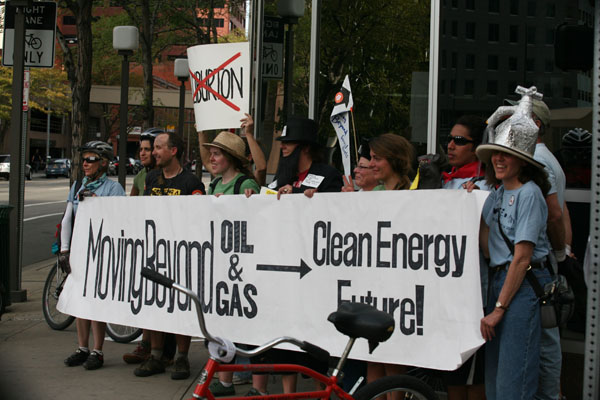
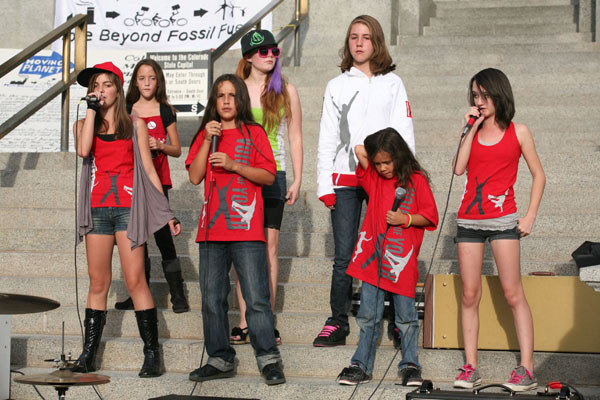
Earth Guardians perform at the Moving Planet Green Fair, Capitol Building, Denver, CO. ©2011 Debra Josephs
This article from Energy Times hits many of the main points everyone needs to be aware of and is a key article for legislators and elected officials to read.
http://www.energybulletin.net/stories/2010-09-30/high-risk-fossil-fuel-boom-sweeps-across-north-america 30 SEP 2010: ANALYSIS A High-Risk Energy Boom Sweeps Across North America Energy companies are rushing to develop unconventional sources of oil and gas trapped in carbon-rich shales and sands throughout the western United States and Canada. So far, government officials have shown little concern for the environmental consequences of this new fossil-fuel development boom. by keith schneider The most direct path to America’s newest big oil and gas fields is U.S. Highway 12, two lanes of blacktop that unfold from Grays Harbor in Washington State and head east across the top of the country to Detroit. The 2,500-mile route has quickly become an essential supply line for the energy industry. With astonishing speed, U.S. oil companies, Canadian pipeline builders, and investors from all over the globe are spending huge sums in an economically promising and ecologically risky race to open the next era of hydrocarbon development. As domestic U.S. pools of conventional oil and gas dwindle, energy companies are increasingly turning to “unconventional” fossil fuel reserves contained in the carbon rich-sands and deep shales of Canada, the Great Plains, and the Rocky Mountain West. Colorado, Utah, and Wyoming hold oil shale reserves estimated to contain 1.2 trillion to 1.8 trillion barrels of oil, according to the U.S. Department of Energy, half of which the department says is recoverable. Eastern Utah alone holds tar sands oil reserves estimated at 12 billion to 19 billion barrels. The tarsands region of northern Alberta, Canada contains recoverable oil reserves conservatively estimated at 175 billion barrels, and with new technology could reach 400 billion barrels. Deep gas-bearing shales of the Great Plains, Rocky Mountain West, Great Lakes, Northeast, and Gulf Coast contain countless trillions of feet of natural gas. If current projections turn out to be accurate, there would be enough oil and gas to power the United States for at least another century. But even as one of the largest energy booms in history has erupted along a great arc of the continent, the consequences are prompting civic discontent, lawsuits, and political battles in state capitals. The boom is producing fresh scars on the land and new threats to scarce water supplies. Government studies show that exploiting unconventional fossil-fuel reserves generates more C02 emissions than drilling for conventional oil and gas and uses three to five times more water. “It’s a pact with the devil,” says Randy Udall, a consulting energy analyst from Colorado. “The tar sands and shale oil and shale gas require a lot of water. It sets up a collision course for the West.” In communities from Wyoming to Texas, thousands of trucks now rumble down rural roads, carrying the huge amounts of water — 2 million to 4 million gallons per well — needed to free oil and natural gas from shales by blasting them with high-pressure fluids. In places such as North Dakota, which receives modest amounts of rainfall, local residents and conservationists worry that the energy boom will deplete aquifers. And the explosion in development of these unconventional fossil fuels raises a troubling question at the national level: At a time when the country should be embracing a renewable energy revolution, it is hurtling in the opposite direction, developing on a massive scale sources of energy that cause considerably more environmental harm than conventional oil and gas drilling. Highway 12 is a crucial supply route for this burgeoning industry, with fossil fuel companies using the road to reach a good portion of the West’s new oil and gas domain that lies to the north and south of the highway. The companies transport equipment 900 miles north to Alberta, Canada, where they are spending $15 billion annually to develop the region’s tar sands, now the single largest source of oil imports to the U.S. and the fastest-growing source of CO2 emissions in Canada, according to the Pembina Institute, a Canadian environmental think tank. In North Dakota — which has become the fourth-largest oil-producing state in the country, with an estimated 100 million barrels being pulled out of deep shales this year and where 1,000 wells will be drilled in 2010 — Highway 12 crosses the $5 billion, 2,151-mile Keystone Pipeline. It is the centerpiece of a $31 billion network of major transport lines either planned or under construction to carry oil from the middle part of the continent to refineries in Texas, Oklahoma, and Illinois that are being modernized and expanded at a cost of more than $20 billion. In all, according to company reports and state economic development offices, the oil industry is spending nearly $100 billion annually in the U.S. to perpetuate the fossil fuel era. Oil industry executives say their investments are consistent with the national goal of producing more energy to increase security. Oil companies are also profiting handsomely from the exploitation of these unconventional sources of oil and natural gas. The stakes became clear earlier this year, when ExxonMobil paid $41 billion to buy XTO Energy, a major player in unconventional fuels production, especially natural gas. Last year, in a much-disputed draft environmental impact statement that summarized the need for the new Keystone-XL pipeline — which will transport oil from Alberta’s tar sands to U.S. refineries — the U.S. Department of State tacitly backed the new energy boom. “The increasing demand for crude oil in the U.S. cannot be entirely met by efforts to conserve use of refined petroleum products or the increased use of renewable energy,” the department said. “As crude oil demand increases, the overall domestic supplies of crude oil are declining.” The department’s analysts added that without the pipeline and the new supplies of oil it would carry, the country “would remain dependent upon unstable foreign oil supplies from the Mideast, Africa, Mexico, and South America.” One of the flashpoints is occurring in northern Idaho and eastern Montana, where oil companies want to use Highway 12 to dispatch the largest convoy of oversized trucks ever assembled to Alberta’s tar sands and elsewhere. The trucks, nearly as long as football fields and so wide they cover both lanes of the highway, haul refining and processing equipment that weighs hundreds of tons and is as tall as a mansion. ConocoPhilips was granted a road permit in Idaho last month to haul four Korean-built oversized oil-processing units from Lewiston, Idaho, where they were offloaded from Columbia River barges, to the company’s expanding refinery in Billings, Montana. Earlier this month, Idaho Second District Judge John Bradbury revoked the permit, asserting that the state did not adequately assess the hazards of the shipment, particularly the consequences of an accident involving one of the immense processing units blocking the highway. Local officials in Montana are considering similar legal action. The court judgment in Idaho, which is set for an appeal on Oct. 1, could have significant ramifications for ExxonMobil Canada, which wants to make 207 oversize hauls next year along Highway 12. Exxon’s trucks will carry even larger Korean-built units to be assembled into a new tar sands oil processing plant in Alberta. The company says it must use Highway 12 because the loads are too big to fit under bridges along interstate highways or rail lines. Despite opposition, the oil and gas industry is undeterred. The Bakken Shale that lies 10,000 feet beneath a 200,000 square mile expanse of North Dakota, Montana, and Saskatchewan is said by the U.S. Geological Survey to contain more than 4 billion barrels of oil and trillions of cubic feet of natural gas. Oil industry geologists say there is much more than that in the Bakken, and in a second oil-rich shale reserve, the Three Forks, that lies below it. Spurred by the Bakken riches, energy companies are now spending tens of millions of dollars to lease mineral rights in Wyoming and Colorado and are drilling exploratory wells in the Niobrara Shale, which sprawls beneath both states. “It just almost boggles the mind,” Lynn Helms, director of the North Dakota Department of Mineral Resources, told a veterans group in Minot on Sept. 2. “It is not like the traditional oil and gas play.” A 2006 study by the Department of Energy that looked at rising energy demand and diminishing freshwater supplies found that the collision between the two was occurring most violently in the fastest-growing parts of the country that also happened to have the scarcest water.resources — California, the Southwest, the Rocky Mountain states, and the Upper Great Plains. It takes 2.5 to 6.5 gallons of water to extract and refine one gallon of tar sands oil, which is four times more water than it takes to produce oil from conventional reserves, according to a 2009 study by Argonne National Laboratory. Moreover, producing tar sands oil, according to the Natural Resources Defense Council, generates as much as three times as many greenhouse gases per barrel as conventional oil production. Extracting unconventional fossil fuel reserves like the Bakken formation uses a lot of water because getting to the oil and natural gas requires rupturing the deep shale to create open spaces and crevices through which the oil and gas can flow. The pulverizing process, called hydraulic fracturing or “fracking,” involves sinking drill bits two miles deep and then turning them to move horizontally through the shale. An armada of tank trucks hauls several million gallons of water to each well site, where pumps shoot it down the well at such super high pressure — 8,000 pounds per square inch — that the rock splits.The practice is risky. Earlier this month, an oil well undergoing fracking near Kildeer, N.D. ruptured. The blowout leaked 100,000 gallons of fracturing fluid and crude oil before being plugged two days later. Fracking has caused contamination of surface and groundwater in other states and harmed drinking water in some communities, according to a number of reports from local environmental organizations.
Fracking Demonstration Impacts the Regulatory Process
http://www.btc-usa.org/joomla15x/
| Written by Brad Thacker | |
| Tuesday, 28 June 2011 02:27 | |
| Sonia Skakich-Scrima, founder of “What the Frack?” Commission, reported that the fracking demonstration held at the S.T.R.O.N.G.E.R. review in Denver sent a message to the Colorado Oil and Gas Commission that ‘business as usual’ is not acceptable. About 25 people rallied in front of the State Land Board office on Thursday, June 23, to push for stronger regulations to protect Colorado’s water, air, and public health. During the rally, some of the demonstrators were interviewed by newspaper and radio reporters throughout the state. Bruce Neslin, the director of the Colorado Oil and Gas Commission, invited the demonstrators into the meeting, perhaps as a tactic to take them out of public view.In the meeting, Sonia reviewed the questions from the STRONGER panel as well as the written responses from Colorado Oil and Gas Commission. Neither the questions from the panel nor the answers from the Oil and Gas Commission substantially addressed key issues impacting public health and water security, in part because neither the panel nor the commission compiled data to review the state-wide impact on Colorado’s environment or the cumulative effect on the health of Colorado citizens. Sonia plans to write up a formal “people’s” response to the STRONGER review, which she will submit to the both the STRONGER review panel and the Colorado Oil and Gas Commission. Look for the report on the “What the Frack?” Commission web blog. | |
| Last Updated on Tuesday, 28 June 2011 05:05 |
Fracking Fight Looms Over Former Lowry Bombing Range
By Brandon Johansson Aurora Sentinel / Posted: Thursday, June 30, 2011 9:27 am The debate over fracking — the controversial oil and gas exploration technique — is set to come to Aurora as state officials consider increased oil drilling on the Lowry Bombing Range east of Aurora.
Critics of the technique, which involves blasting tons of liquid into the ground to free fossil fuels from rock formations, say it could jeopardize Aurora’s water and air.
The Colorado State Land Board owns about 26,000 acres on the range, which stretches east roughly from Aurora reservoir between East Quincy Avenue and County Line Road.
Bill Ryan, director of the Land Board, said officials hope to lease about 20,000 acres of the bombing range land, possibly within a few months. The leases could bring in as much as $500 million in the next 30 to 40 years for the eight state trusts the land board funds, Ryan said. Most of that money goes toward K-12 education, he said. “We’d like to get it to market shortly while the Niobrara is still hot,” he said referring to the ol-rich Niobrara formation that runs along Colorado’s Front Range. About 5,000 acres on the old bombing range have already been leased for oil and gas explorations since the 1970s, Ryan said, and more than 70 wells have been drilled. Some of those wells, he said, likely used fracking.
But this time, as the debate over fracking has heated up around the west and in Congress, a group of local residents are mounting opposition to fracking on the old bombing range. “I don’t want our source of drinking water near fracking. It’s too big a risk,” said Steve Webb of Aurora. Webb was one of about 25 people, many from Aurora, who protested against fracking on the bombing range last week in front of the State Land Board headquarters in Denver.
The protesters said they were opposed to fracking on the bombing range because the area is so close to the city and so close to drinking supplies like the Aurora Reservoir.
Dave Neslin, director of the Colorado Oil and Gas Commission, which regulates drilling in Colorad, said any fracking at the range would likely occur between 7,000 and 8,000 feet below the surface. Usable ground water in Colorado is typically found less than 1,000 feet deep, he said. “There is going to be more than one mile of geologic formation separating the formations being fractured from any drinking water or from the surface for that matter. That significantly minimizes any risk,” he said.
Sonia Skakich-Scrima, one of the Aurora Residents opposed to the proposal, said increased drilling on th bombing range would harm eastern Aurora neighborhoods like hers. “It has huge environmental impacts on water, on air, on noise, on truck traffic,” she said.
A meeting is scheduled for 6:30 p.m. July 6 at Smoky Hill Library, 5430 S. Biscay Cir. to discuss the issue.
Skakich-Scrima, who is circulating petitions against fracking and increased drilling at the bombing range, said she is concerned that new wells could use riskier forms of fracking than the 70 current wells at the range already use. In particular, Skakich-Scima said she is worried abou the possibility of “horizontal fracking,” which involves more water than other fracking and could be more harmful.
But Neslin said regardless of the kind of fracking used, the process will be heavily regulated. “The bottom line, from our standpoint, is hydraulic fracturing really is ubiquitous for oil and gas development today. Virturally all wells in the state that are being drilled are being hydraulically fractured and we could not produce anywhere near as much energy as we produce without hydraulic fracturing,” he said.
To view online article and photos: http://www.aurorasentinel.com/email_push/news/article_97952064-a32d-11e0-95a6-001cc4c002e0.html 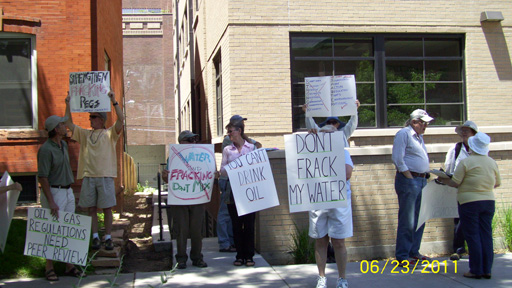 “Protesters against fracking in Colorado, at the STRONGER review in Denver on 6/23/11. Photo by Michele Swenson”
“Protesters against fracking in Colorado, at the STRONGER review in Denver on 6/23/11. Photo by Michele Swenson”
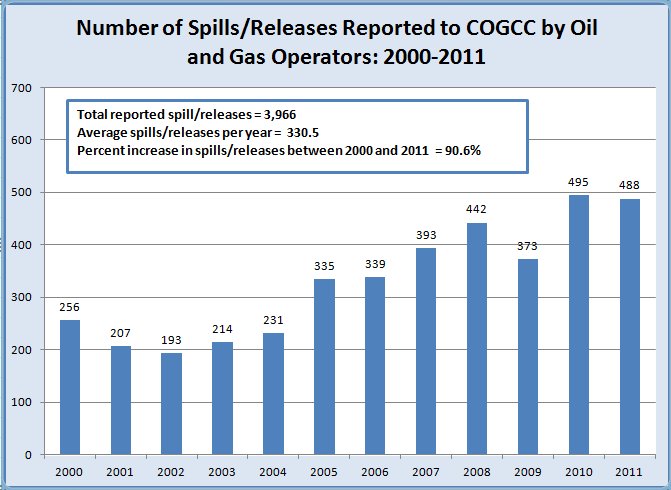
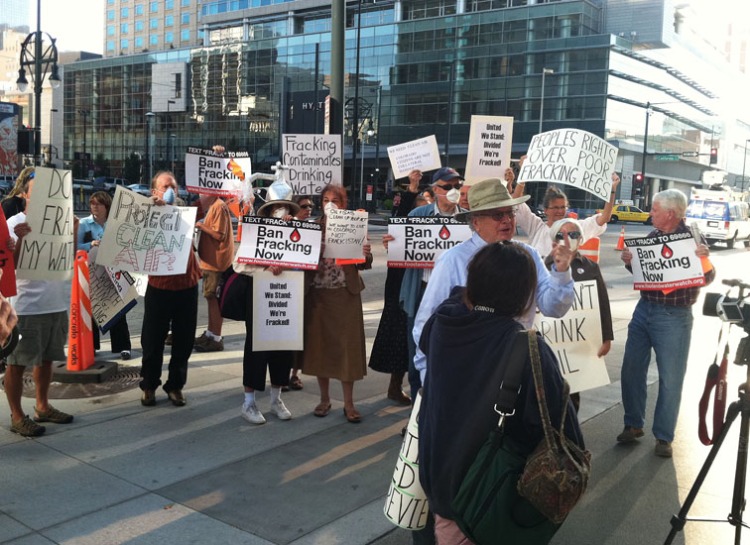
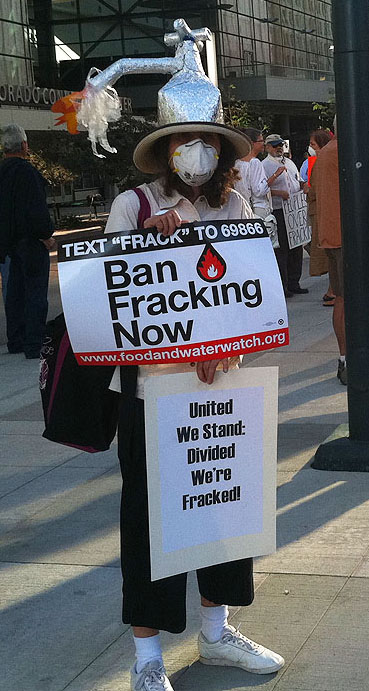
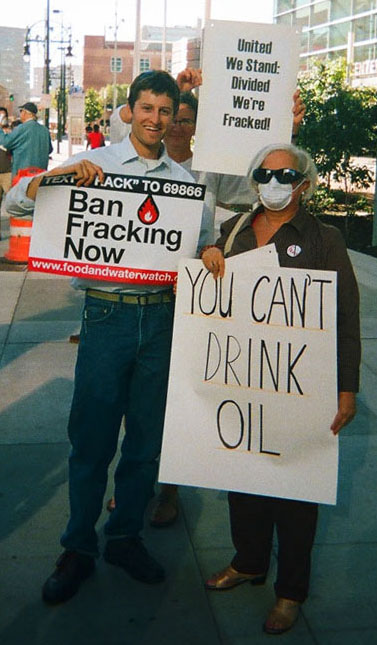
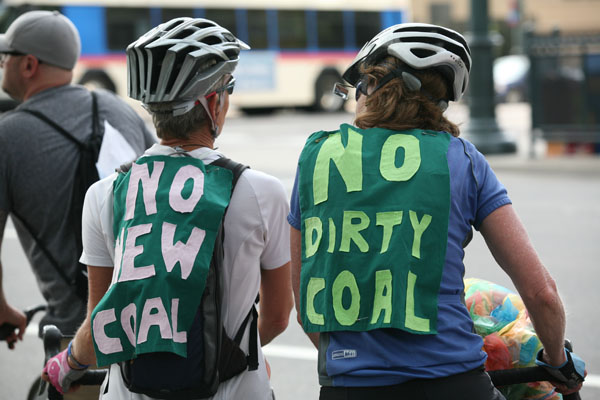

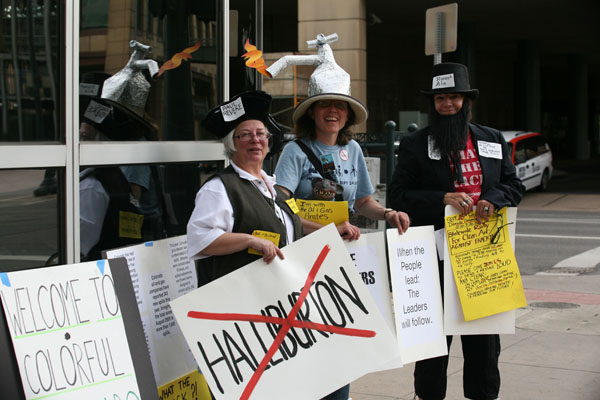
Discussion
No comments yet.